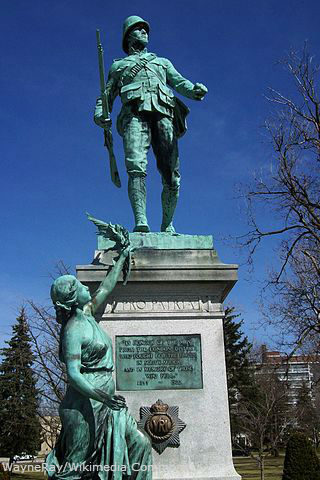Canada’s London may have its own Thames River, but don’t get it confused with the British capital; this Ontario city is distinctly Canadian. 
“The Forest City” has a long history of natural disasters: a fire, a cholera outbreak and a tornado all nearly destroyed London between its 1826 founding and today. Despite that historic tough luck, London has persevered to become one of Canada’s biggest cities.
London’s Climate
London experiences all four seasons like nearby North American cities, but it’s location near Lake Erie and Lake Huron moderate the temperatures and increase precipitation.
London summers are warm and humid. The average temperature in July is 21 degrees Celsius, but the humidity from the lakes makes it feel warmer. It also is not uncommon for temperatures to rise above 30 degrees on particularly hot days.
Winters can get cold but are slightly warmed by the lake effect. There are four months out of the year with average temperatures below the freezing point, but the coldest month, January, only has a daily mean of -6 degrees Celsius.
The convergence of the breezes from the adjacent lakes also causes London to have a lot of heavy and sometimes unpredictable precipitation. Despite occasional thawing periods, the city gets over two metres of snow each year. In summer, thunderstorms are common and the occasional funnel cloud is possible.
London Neighbourhoods
London’s “Forest City” moniker accurately describes its outer neighbourhoods, but belies how urban the heart of the city is.
Like many big cities, London's formerly neighbouring municipalities remain distinct neighbourhoods after their annexations. Westminster, Stoneybrook, Westmount, Oakridge, Pond Mills, Whitehills and White Oaks are all neighbourhoods that used to belong to their own, more rural towns.
In contrast, Wellington Street is at the urban centre of London and despite being primarily commercial, some expensive housing is available there.
But who lives in London? It is roughly 82 percent white and 63 percent Christian, but there are several visible minority neighbourhoods within London. Aboriginals, Chinese, Latin Americans, Arabs, South Asians and African Canadians each make up two to three percent of the population.
Registering Your Car in London
If you are moving to London from outside of the province, you need to register your car by Southern Ontario regulations. Typically, you will need your car’s title, insurance and inspection records. For more information on registering your vehicle in Ontario, visit Service Ontario’s website. London Transportation London Transportation
London is directly connected to both Detroit and Toronto by Highway 401, which makes it a popular stop for international travellers. London’s important location also makes the city’s Via Rail station the fourth busiest in Canada.
Public transportation within the city is run by the London Transit Commission. It provides 38 bus routes, but London is currently considering expanding its public transportation options to keep up with heavy commuter traffic. There are no rail commuter options in the city, but there are several taxi services.
London recently constructed cycleways to reduce traffic, but they currently only run along some of the city’s busiest roads.
London Schools
For elementary and secondary schooling, the Thames Valley District School Board and the London District Catholic School Board govern the city’s public secular and Catholic schools, respectively. Their French-speaking counterparts are the Conseil scolaire Viamonde and the Conseil scolaire catholique Providence. There are also over 20 private schools in London.
London’s post-secondary schools include the University of Western Ontario and Fanshawe College. UWO educates roughly 30,000 undergrads and graduates each year and is considered one of the country’s top universities. Fanshawe is a college for applied arts and technologies that offers undergraduate courses to approximately 15,000 full-time students each year.
London’s Economy
London’s economy is driven primarily by insurance, medical research and information technology. The University of Western Ontario also accounts for a large portion of the city’s economy, adding about $1.5 billion to the economy each year.
Major London employers include:
- London Life Insurance
- The University of Western Ontario
- Imperial Oil
- Labatt Brewery
- Canada Trust
- Libro Financial Group
London’s unemployment rate is trending downward after a period of highs. As of February 2015, London’s unemployment was at 7.2 percent, down from 7.8 the previous year.
London Cost of living
Unlike its British namesake, Ontario’s London has a low cost of living. Compared to a big Canadian city like Toronto, London is a cheaper place to live in almost all regards. If you rented in both cities, a little over $4,200 in London would go as far as $5,100 in Toronto. Rent is especially low, with prices in the $800 to $900 range for a one-bedroom apartment in the city centre. 
Just remember that public transportation is difficult to procure in London, so you will have to pay for gas more frequently than in other big cities.
London Culture and Contemporary Life
London has a lot to offer both tourists and residents alike. In many ways, it represents a meeting of new and old styles--and urban and rural neighbourhoods. There’s something for everyone in this dynamic city.
If you’re looking for the typical urban entertainment, head down Wellington Street in Downtown London to find restaurants, shops, bars and other interesting venues.
Would you rather experience some of the Forest City’s natural beauty? Take a walk through the scenic and historic Fanshawe Pioneer Village.
If you’re looking for events, London hosts a myriad of seasonal festivals each year:
- Sunfest- An international music festival that is the second biggest in Canada.
- Western Fair- A late-summer fair with a variety of attractions, located in Downtown London.
- The London Fringe Theatre Festival- An annual celebration of theatre with a focus on local play writers.
- The London Rib-Fest- A variety of events celebrating cooking and eating barbecue ribs.
London also has several museums for art lovers to explore. Museum London is located right at the Forks of the Thames and has a wide variety of pieces and exhibits that celebrate local and national culture. You can take your family to the London Children’s Museum to keep the kids occupied. If anthropology interests you, try the Museum of Ontario Archaeology. It is owned by the University of Western Ontario and is involved in active excavation of prehistoric villages.
London is also home to several noteworthy Canadian Heritage sites. There's Eldon House, the city’s oldest building, and The Banting House, where Sir Fredrick Banting supposedly came up with the method that lead to his historic discovery of insulin.
London Moving Resources
Are you ready to move to London? Topmoving.ca has a database of moving companies that can help you with any moving service you need to make your relocation go smoothly. Click on the following links to get access to London companies that can provide you with the indicated service. Get at least three different estimates from three different companies. Comparing multiple quotes will let you determine what a good price is for your move before you commit to one company.
London Relocation Tips
- Only plan to bike to work if you know that there are decent paths in place. Only high-traffic areas have cycling lanes in London.
- Prepare for extreme weather. London is in a convergence zone of breezes from the nearby Great Lakes, so it is prone to snow and thunderstorms.
- Crime in London is generally low, but residents do have concerns about property crime and drugs according to a Numbeo survey.
- Due to annexations, London covers a large area. Make sure you are moving into a neighbourhood that is located somewhere convenient for your job and interests.
Helpful Links
|